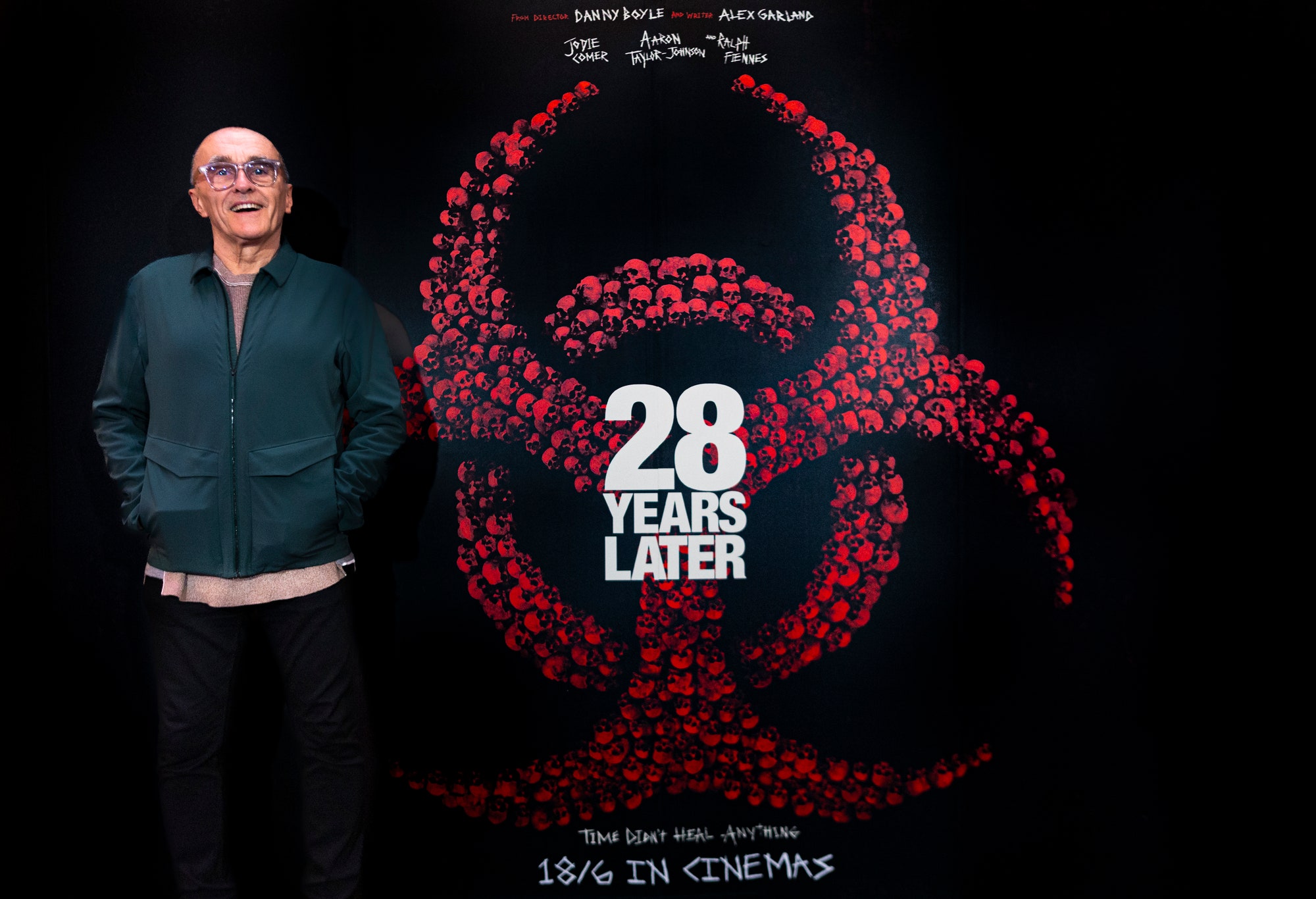In 2001, Danny Boyle had a problem. To make his new postapocalyptic horror movie, 28 Days Later, he had to capture footage of a then-unknown Cillian Murphy wandering the abandoned streets of London. Shutting down the city wasn’t an option for the low-budget production, however, and neither was re-creating it on a studio set. Instead, the 68-year-old director made a surprising choice: He filmed with lightweight, low-resolution Canon digital cameras. The technology, which was cutting-edge at the time, made it possible to record scenes at iconic locations like Westminster Bridge and Piccadilly Circus in under an hour each. It also gave 28 Days Later its unique grainy look that makes the movie stand out even today.
Almost three decades later, Boyle faced a similar dilemma. As its title suggests, 28 Years Later takes place exactly 28 years after the initial outbreak of a zombie-like “Rage Virus.” Abandoned by the rest of the world, a quarantined United Kingdom has returned to its natural state, even as pockets of humans and zombies survive. To bring that vision to life, Boyle once again had to rely on lightweight cameras to film in locations he normally wouldn’t be able to. But this time, the location was the untamed wilderness of Northumbria, and the camera was an iPhone.
“Filming with iPhones allowed us to move without huge amounts of equipment,” Boyle tells WIRED. “A lot of Northumbria looks like it would have looked 1,000 years ago. So we were able to move quickly and lightly to areas of the countryside that we wanted to retain their lack of human imprint.”
28 Years Later is a full-circle moment for Boyle, in more ways than one. The original movie turned its director, best known at the time for dark comedies like Trainspotting, into a genre-hopping auteur. But in the decades since, he has resisted revisiting this postapocalyptic setting, mostly sitting out the 2007 sequel 28 Weeks Later. His return, sparked in part by the Covid-19 pandemic, which brought Boyle’s vision of an emptied London to life, takes the franchise in some surprising directions that both set up an entire new trilogy and manage to tell a beautiful story about life, death, and the unbreakable bond between parent and child.
For Boyle, these were all valid reasons to reexamine the world he created with screenwriter Alex Garland. But there was never going to be a wrong time to make this movie—even if the timing feels particularly prescient in the context of our own apocalyptic reality.
“There has been no diminishing of the appetite for apocalyptic stories,” Boyle says. “Whether that’s because we’re in the worst of times, I don’t know. Certainly, the horrors of the world have not diminished since we made the first film. If anything, they’ve gotten worse, and they bleed into the film, whether it’s the horrors of war or the horrors of infection.”
Ahead of the movie’s release, WIRED spoke to Boyle about why now was the perfect time for a sequel, the advantages and drawbacks of shooting on iPhone, and why he couldn’t wait 28 actual years to release 28 Years Later.
“Poor Man’s Bullet Time”
Earlier this month, IGN published a behind-the-scenes look at 28 Years Later, revealing a massive rig capable of pointing 20 iPhone 15 Pro Max cameras (all outfitted with special accessories) at their subject. Speaking to me over Zoom, Boyle explains how this smartphone array, organized in a half-circle, lets the director capture complex action scenes from multiple angles at once.
“It allowed us to do what is basically a poor man’s bullet time,” he says, referencing the effect pioneered by The Matrix. But while The Matrix used bullet time to visualize its physics-defying combat, Boyle’s goal was to capture the brutality of his world. “We use it for the violence. It was startling and unexpectedly depicted at times.”
Boyle’s use of iPhones wasn’t limited to those giant rigs. He notes that the Apple device was the “principal camera” for the film and praises the “immediacy” of shooting on a smartphone over a traditional movie camera. “Although it’s a recording device, because of people’s familiarity with it, actors are slightly different with it,” Boyle says. In some scenes, he even handed an iPhone to the actors and had them film from their perspective.
There were some minor disadvantages to this method, Boyle admits, mostly due to Apple’s user-friendly camera software. “You have to override the working system,” the director says. For example, the iPhone’s camera automatically focuses on whatever it assumes is the focus of your photo or video. That’s a useful feature for snapping quick selfies, but for a film director it’s a problem. “Drama is often not following necessarily where the brightest light or the largest object is,” Boyle says. “It’s where you want the story to be.”
These small annoyances were easily outweighed by the many advantages of filming the movie with iPhones, Boyle says. He praises the high resolution of the device, which is capable of shooting at 4K resolution at up to 60 frames per second and allowed him to capture both gorgeous locations and the brutal violence on a camera that weighs a fraction of the ones used to film 28 Days Later.
“It gives you a recording of beauty and nature that was a huge part of what we wanted to contrast the horror with,” he says.
Inspired by Covid-19
Boyle never thought the world he depicted in 28 Days Later would become a reality. Then, a global pandemic swept across the world.
“You saw cities emptied overnight in a way that one would have thought unimaginable outside a movie,” he says. “Then it literally happened in people’s lives.”
But while the global lockdowns of 2020 gave Boyle a sense of déjà vu for 28 Days Later, it was what happened immediately afterward that inspired him to make a sequel.
“The big discovery was thinking about our own behavior after Covid,” Boyle says.
In the first weeks or months of the pandemic, you probably washed your hands for a full 20 seconds every time you got home, and you wore a face mask outside. You might have even sanitized your groceries. But as lockdown dragged on, you likely stopped some, if not all, of that behavior.
“You start to take risks over time,” Boyle says. “It was something we could all relate to. We all had stories.”
Boyle and Garland applied that same thinking to the world of 28 Years Later. Their sequel follows a community living on an island off the northeast coast of England and connected by a single causeway that floods each night with the tides. The community of Holy Island (a real place in the UK) manages to keep out the Rage Virus completely, and, over the years, they begin to explore the mainland, despite the inherent dangers.
“Twenty-eight years after an infection, there would be risk-taking,” Boyle says. “There’d be enormous amounts of risk-taking, because they’d have worked out the parameters of how far they can go and still stay safe.”
He brings up the dangers of getting the virus if the blood of an infected enters your body: “In the original movie, if you got a fleck of blood on you, you were hacked to death by your fellow survivors. Whereas in this one, they can operate. That was really interesting, and that came out of Covid for us.”
The Legacy of 28 Days Later
In the 22 years since Boyle’s genre-redefining movie, zombie storytelling has changed dramatically, thanks in large part to screenwriter Garland’s vision for fast-moving Infected. (In interviews, Garland has revealed he drew inspiration from the zombie dogs in the Resident Evil video games.) Subsequent movies like World War Z, Zombieland, and Train to Busan all borrowed liberally from 28 Days Later.
But while Boyle is proud of his influence on the zombie film landscape, he’s mostly abstained from watching any of those movies himself.
“I’ve tended to stay away from them,” the director says. “I always thought it was useful that Alex was an expert and I wasn’t. That was a good dynamic in the way we’d approach the films. You have to be careful about either being too reverential or too avoidant. They’re both equally dangerous instincts.”
Boyle adds that he relied on Garland to warn him when 28 Years Later felt too similar to another zombie movie, while admitting that the writer also took some inspiration from more recent additions to the genre.
“I know he’s an enormous admirer of The Last of Us game,” Boyle says. “In fact, I think that was influenced by 28 Days Later. One hand washes the other, in that respect.”
Ultimately, 28 Years Later is just one of many movies pushing the zombie genre forward through both storytelling and technological innovations. And while the wait for a proper sequel has been long and winding, it appears to be arriving at the exact right time. Then again, as my time with Boyle comes to a close, I can’t help but wonder why he didn’t wait a few more years until 2031, when the film’s title would have literally described the span of time between the original and its overdue follow-up.
When I pose the question, Boyle’s answer reveals his unique perspective—dark, witty, and unmistakably British—that made the franchise a hit all those years ago.
“It would have been cute, as the Americans say, and very neat for marketing, but I couldn’t guarantee I’d still be alive by then,” he says with a wicked smile. “So we thought we should move now, just in case.”




